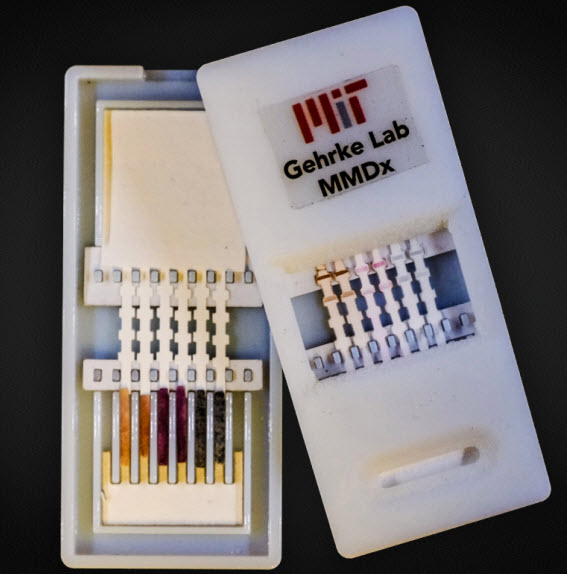A quick color-coded test for Ebola
February 24, 2015

A new paper diagnostic device can detect Ebola and other viral hemorrhagic fevers in about 10 minutes. The device has silver nanoparticles of different colors that indicate different diseases. On the left is the unused device, opened to reveal the contents inside. On the right, the device has been used for diagnosis; the colored bands show positive tests. (credit: Jose Gomez-Marquez, Helena de Puig, and Chun-Wan Yen)
A new test for Ebola from MIT researchers uses a simple paper strip similar to a pregnancy test that can rapidly diagnose Ebola, as well as other viral hemorrhagic fevers such as yellow fever and dengue fever.
The new device is described in the journal Lab on a Chip.
Color-coded test
Currently, the only way to diagnose Ebola is to send patient blood samples to a lab that can perform advanced techniques such as polymerase chain reaction (PCR), which can detect genetic material from the Ebola virus. This is very accurate but time-consuming, and some areas of Africa where Ebola and other fevers are endemic have limited access to this kind of technology.
The new device relies on lateral flow technology, which is used in pregnancy tests and has recently been exploited for diagnosing strep throat and other bacterial infections. Until now, however, no one has applied a multiplexing approach, using multicolored nanoparticles, to simultaneously screen for multiple pathogens.
Unlike most existing paper diagnostics, which test for only one disease, the new strips are color-coded so they can be used to distinguish among several diseases. To achieve that, the researchers used triangular nanoparticles, made of silver, that can take on different colors depending on their size.

TEM images of c) silver (Ag) seeds, d) orange AgNPs, e) red AgNPs, and f) green AgNPs. Scale bars: 50 nm. g) Green, red, and orange (top to bottom) AgNPs on nitrocellulose paper. (credit: Chun-Wan Yen/Lab on a Chip)
The researchers created red, orange, and green silver nanoparticles and linked them to antibodies that recognize Ebola, dengue fever, and yellow fever. As a patient’s blood serum flows along the strip, any viral proteins that match the antibodies painted on the stripes will get caught, and those nanoparticles will become visible. This can be seen by the naked eye; for those who are colorblind, a cellphone camera could be used to distinguish the colors.
“When we run a patient sample through the strip, if you see an orange band you know they have yellow fever, if it shows up as a red band you know they have Ebola, and if it shows up green then we know that they have dengue,” Hamad-Schifferli says.
This process takes about 10 minutes, allowing health care workers to rapidly perform triage and determine if patients should be isolated, helping to prevent the disease from spreading further.
Warren Chan, an associate professor at the University of Toronto Institute of Biomaterials and Biomedical Engineering, says he is impressed with the device because it not only offers faster diagnosis, but also requires smaller patient blood samples, as just one test strip can detect multiple diseases. “It’s a step up from what everyone else is doing,” says Chan, who was not involved in the research. “They’re targeting diseases that are really relevant to what’s going on in the world at this point, and have shown that they can detect them simultaneously.”
The researchers hope to obtain FDA approval to begin using the device in areas where the Ebola outbreak is still ongoing. To do that, they are now testing the device in the lab with engineered viral proteins, as well as serum samples from infected animals.
This type of device could also be customized to detect other viral hemorrhagic fevers or other infectious diseases, by linking the silver nanoparticles to different antibodies.
The research was funded by the National Institute of Allergy and Infectious Disease.
Abstract for Multicolored silver nanoparticles for multiplexed disease diagnostics: distinguishing dengue, yellow fever, and Ebola viruses
Rapid point-of-care (POC) diagnostic devices are needed for field-forward screening of severe acute systemic febrile illnesses. Multiplexed rapid lateral flow diagnostics have the potential to distinguish among multiple pathogens, thereby facilitating diagnosis and improving patient care. Here, we present a platform for multiplexed pathogen detection using multi-colored silver nanoplates. This design requires no external excitation source and permits multiplexed analysis in a single channel, facilitating integration and manufacturing.